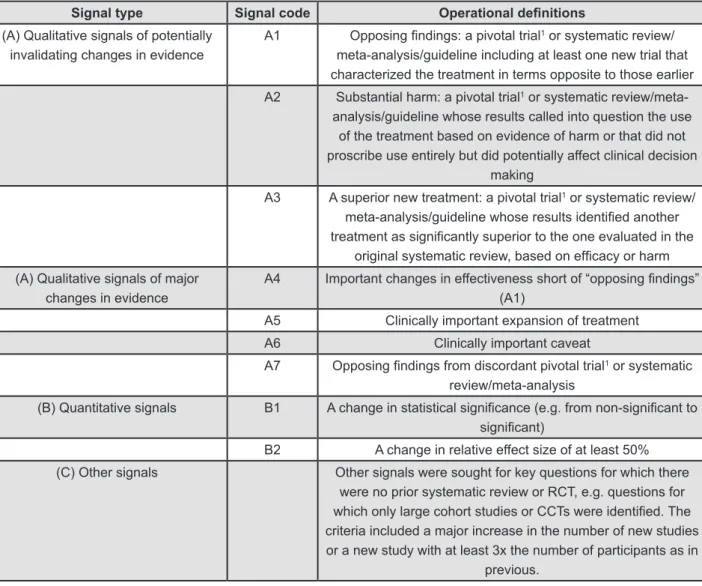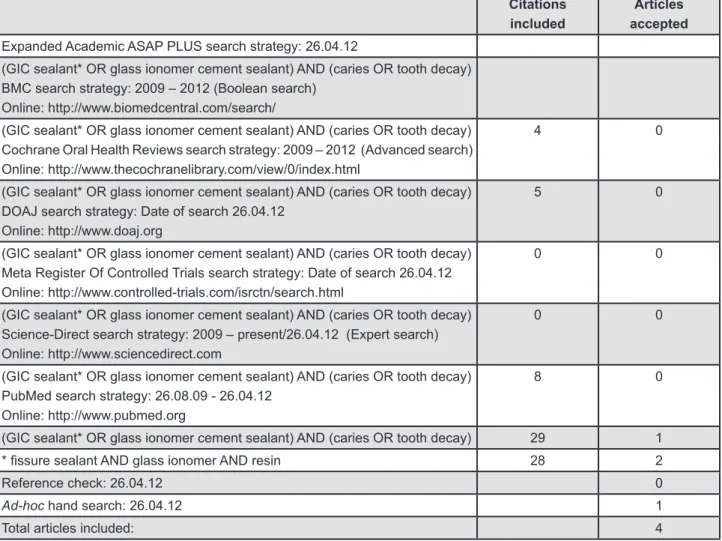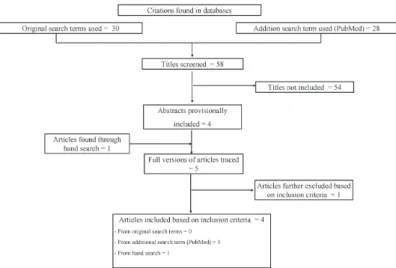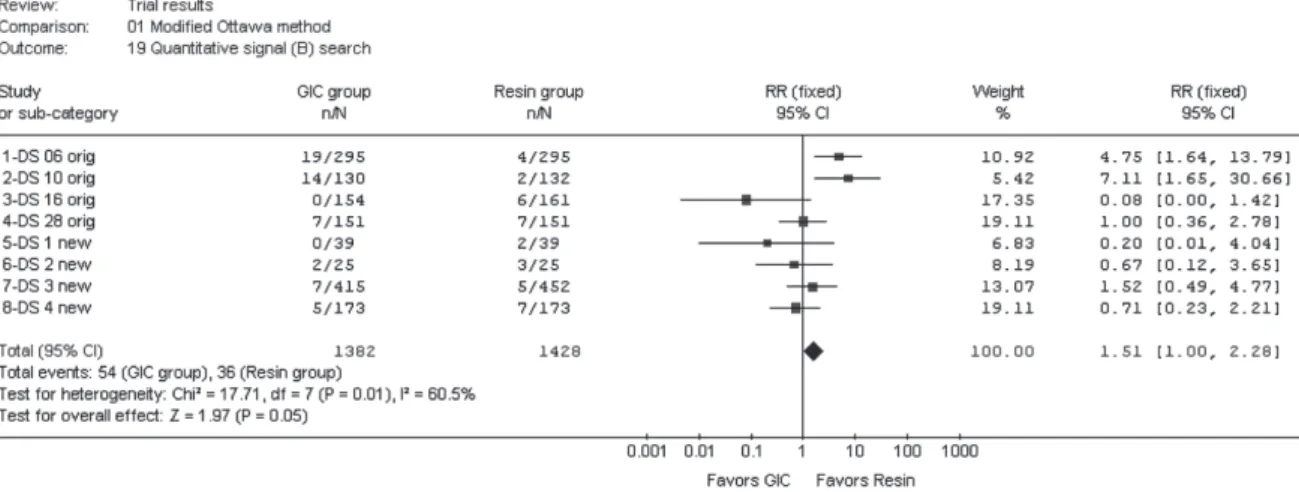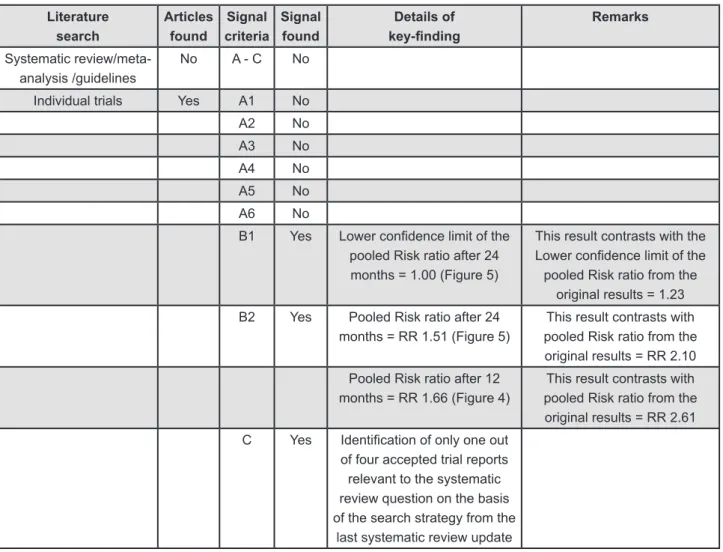ABSTRACT
The modiied Ottawa method to establish the
update need of a systematic review: glass-ionomer
versus resin sealants for caries prevention
Steffen MICKENAUTSCH1, Veerasamy YENGOPAL1
1- SYSTEM Initiative/Department of Community Dentistry, Faculty of Health Sciences, University of the Witwatersrand, Johannesburg, South Africa.
Corresponding address: Steffen Mickenautsch - SYSTEM Initiative/Department of Community Dentistry, Faculty of Health Science - University of the Witwatersrand - 7 York Rd. - Parktown/Johannesburg - 2193 - South Africa - Phone: +27 11 717 2594 - Fax +27 11 717 2625 - e-mail: neem@global.co.za
Submitted: January 8, 2013 - Modiication: April 11, 2013 - Accepted: August 27, 2013
O
bjective: To demonstrate the application of the modiied Ottawa method by establishing the update need of a systematic review with focus on the caries preventive effect ofGIC versus resin pit and issure sealants; to answer the question as to whether the existing
conclusions of this systematic review are still current; to establish whether a new update of
this systematic review was needed. Methods: Application of the Modiied Ottawa method.
Application date: April/May 2012. Results: Four signals aligned with the criteria of the
modiied Ottawa method were identiied. The content of these signals suggest that higher
precision of the current systematic review results might be achieved if an update of the current review were conducted at this point in time. However, these signals further indicate
that such systematic review update, despite its higher precision, would only conirm the existing review conclusion that no statistically signiicant difference exists in the caries-preventive effect of GIC and resin-based issure sealants. Conclusion: In conclusion, this study demonstrated the modiied Ottawa method as an effective tool in establishing the
update need of the systematic review. In addition, it was established that the conclusions of the systematic review in relation to the caries preventive effect of GIC versus resin
based issure sealants are still current, and that no update of this systematic review was
warranted at date of application.
Keywords: Glass-ionomer cements. Resins. Fissure sealants. Caries. Systematic review.
Modiied Ottawa method.
INTRODUCTION
In 2009, the authors of this study published a systematic review (search cut-off date: 15 January 2008), in order to appraise the then current evidence regarding the caries-preventing effect of glass-ionomer cement (GIC) in comparison to that of resin-based fissure sealants16. This
systematic review with meta-analysis found no evidence that either material was superior to the other in the prevention of dental caries. Therefore, both appeared to be equally suitable for clinical application as issure sealant materials.
In 2011, this systematic review was updated and the overall outcome was judged to be in agreement with the conclusions of the original systematic review9. The cut-off date for the systematic literature
search of this update was the 26th of August 2010.
At the beginning of 2012, the authors considered the question as to whether a further update would be needed. The Cochrane collaboration advocates a preset time-based approach, with a recommended frequency of two years, for initiating the update of an original systematic review5.
In contrast, the use of a priority approach towards the updating of systematic reviews has been recently suggested14. Such an approach
relies on the identiication of signals indicating update needs. The Agency for Healthcare Research and Quality's (AHRQ) evidence-based Practice Center (ePC) program conducted studies aimed at developing reliable methods for assessing the need for updating of systematic reviews4. Consequently,
“Ottawa method”. The modiied Ottawa method relies on identiication of qualitative, quantitative and “other” signals from new systematic review-, meta-analysis- or trial reports published (or otherwise made available) after the search date of an original systematic review. In order to identify new reports, a systematic literature search is conducted. Criteria for signals that indicate the need to update a systematic review report are shown in Figure 14. Quantitative signals (B1 and B2) are
obtained by pooling data extracted from identiied new trials with the data from the original systematic review, using a ixed effects meta-analysis. The pooled results are then compared with the original systematic review results for any possible changes in statistical signiicance (B1) or effect size (B2). As the purpose of the meta-analysis is to identify signals indicating a potential need to update an original systematic review, and not to establish a revised effect estimate, this simpliied use of meta-analysis (without considering pooled data
heterogeneity) has been reported as suficient4. The
underlying criteria of this method were found to be effective during a study of 100 systematic reviews published from 1995 to 20057.
As the modiied Ottawa method is still fairly new, this study aims to demonstrate its application by establishing the update need of a systematic review with focus on the caries preventive effect of GIC versus resin pit and issure sealants9. As
health care providers and policymakers depend on up-to-date evidence from systematic reviews, this study aims further to answer the question as to whether the existing conclusions of this systematic review9 are still current and whether a new update
of it is needed.
MATERIAL AND METhODS
The modiied Ottawa method was applied4. In
accordance with this method; a basic literature search was conducted on the 26th of April 2012,
Signal type Signal code Operational deinitions
(A) Qualitative signals of potentially invalidating changes in evidence
A1 Opposing indings: a pivotal trial1 or systematic review/
meta-analysis/guideline including at least one new trial that characterized the treatment in terms opposite to those earlier
A2 Substantial harm: a pivotal trial1 or systematic
review/meta-analysis/guideline whose results called into question the use of the treatment based on evidence of harm or that did not proscribe use entirely but did potentially affect clinical decision
making
A3 A superior new treatment: a pivotal trial1 or systematic review/
meta-analysis/guideline whose results identiied another treatment as signiicantly superior to the one evaluated in the
original systematic review, based on eficacy or harm (A) Qualitative signals of major
changes in evidence
A4 Important changes in effectiveness short of “opposing indings” (A1)
A5 Clinically important expansion of treatment
A6 Clinically important caveat
A7 Opposing indings from discordant pivotal trial1 or systematic
review/meta-analysis
(B) Quantitative signals B1 A change in statistical signiicance (e.g. from non-signiicant to signiicant)
B2 A change in relative effect size of at least 50%
(C) Other signals Other signals were sought for key questions for which there were no prior systematic review or RCT, e.g. questions for which only large cohort studies or CCTs were identiied. The criteria included a major increase in the number of new studies or a new study with at least 3x the number of participants as in
previous.
Figure 1- Modiied Ottawa method: signal criteria
RCT=Randomised control trial; CCT=Case control trial
using the search strategy presented in Figure 2. The search strategy included the same string of english search terms and databases as those utilized in the last systematic review update, concerning the caries-preventive effect of GIC-based issure sealants versus that of resin9. The search period
for the PubMed search chosen was from 26 August 2009, being one year before the date of the last systematic review update (26 August 2010), to 26 April 2012. All other databases were searched from 2009 to the present. In addition, an ad hoc hand search was conducted through issues of pivotal journals (Dental Materials, Caries Research, Journal of Dentistry and Journal of Dental Research) published between 2009 and 2012.
In order to verify the validity of the search strategy applied in the last systematic review update, a further string of search terms: “issure sealant AND glass ionomer AND resin” for search in PubMed was also included as the search in this database had generated most of the reviewed articles, so far9.
Both authors independently scanned titles and abstracts of the citations that were identiied
through the literature search. The selection criterion for systematic reviews and/or prospective clinical control trials was relevance to the original systematic review question9: whether teeth sealed
with either GIC or resin developed equivalent caries occurrence on pits and issures. Articles with titles of potential relevance but without abstracts were traced in full for scanning. Disagreements between reviewers were solved by discussion and consensus. Accepted articles were traced in full and reviewed for signals.
Quantitative signals (B1 and B2) were obtained by pooling data extracted from identiied new trials with the data from trials included in the original systematic review, using a ixed effects meta-analysis. These pooled results were then compared with the pooled results of the datasets from the last systematic review update alone9, for any possible
changes in statistical signiicance (B1) or effect size (B2)4.
Fixed effects meta-analysis for the identiication of quantitative signals was conducted, using RevMan Version 4.2 statistical software of the Nordic Cochrane Centre, The Cochrane Collaboration
Citations included
Articles accepted
Expanded Academic ASAP PLUS search strategy: 26.04.12
(GIC sealant* OR glass ionomer cement sealant) AND (caries OR tooth decay) BMC search strategy: 2009 – 2012 (Boolean search)
Online: http://www.biomedcentral.com/search/
(GIC sealant* OR glass ionomer cement sealant) AND (caries OR tooth decay) Cochrane Oral Health Reviews search strategy: 2009 – 2012 (Advanced search) Online: http://www.thecochranelibrary.com/view/0/index.html
4 0
(GIC sealant* OR glass ionomer cement sealant) AND (caries OR tooth decay) DOAJ search strategy: Date of search 26.04.12
Online: http://www.doaj.org
5 0
(GIC sealant* OR glass ionomer cement sealant) AND (caries OR tooth decay) Meta Register Of Controlled Trials search strategy: Date of search 26.04.12 Online: http://www.controlled-trials.com/isrctn/search.html
0 0
(GIC sealant* OR glass ionomer cement sealant) AND (caries OR tooth decay) Science-Direct search strategy: 2009 – present/26.04.12 (Expert search) Online: http://www.sciencedirect.com
0 0
(GIC sealant* OR glass ionomer cement sealant) AND (caries OR tooth decay) PubMed search strategy: 26.08.09 - 26.04.12
Online: http://www.pubmed.org
8 0
(GIC sealant* OR glass ionomer cement sealant) AND (caries OR tooth decay) 29 1
* issure sealant AND glass ionomer AND resin 28 2
Reference check: 26.04.12 0
Ad-hoc hand search: 26.04.12 1
Total articles included: 4
*Additional PubMed search
(Copenhagen; 2003). The Risk ratio (RR) with 95% conidence intervals (CI) and p-values was computed. Alpha level was set at 5%.
The following information was extracted from the accepted trial reports for each intervention group: type of dentition (permanent or primary), length of follow-up period (in months or years) and dichotomous datasets (DS) concerning the outcome measure. The outcome measures included the number of sealed teeth that developed caries (n), from the total number of evaluated teeth (N), for each intervention group. On this basis, datasets (DS) were deined as any extracted set of n/N for the glass-ionomer cement (GIC) and resin groups. The result of one or more datasets concerning one particular type of dentition, tooth cavity, evaluation criteria and follow-up period was considered as a key inding.
Both authors extracted data from accepted trials independently, without being blinded to authors, institutions, journal names and trial results. Disagreements between authors were solved through discussion and consensus.
RESULTS
Literature search and data collection
Figure 3 provides information on the number of articles identiied. The database search using the same search strategy as that of the last systematic review update9 generated 29 citations,
the PubMed search with the additional string of search terms generated 28 citations and ad hoc hand search identiied one citation (Figure 2). From the total of 58 citations, 53 were excluded through scanning of titles and abstracts, and 5 articles1-3,6,15
were included. Only clinical trial reports, and no systematic review, meta-analysis or guideline, were found. Of the clinical trial reports, one2 was
excluded, as its investigation covered comparison of resin with resin-modiied GIC (Vitremer), instead
of conventional GIC. All accepted trial reports were published in 2012.
Of the four accepted trial reports, only one15 was
identiied through use of the search strategy of the previous systematic review update9; two were found
through use of the additional string of search terms: “issure sealant AND glass ionomer AND resin” in PubMed1,6 and one was identiied during ad hoc hand search2. The discrepancy between search results
from the original8 and additional search strategies
was considered to be one signal according to criteria C (Figure 1).
Data analysis and signal identiication
From the four accepted trial reports1,3,6,15, ten
separate datasets (DS) could be extracted: Three datasets: “4-DS 1 new”6, “5-DS 2 new”3
and “6-DS 3 new”15, from three trials related to
comparison of the effect size of resin with that of GIC-based issure sealants after 6 months (Figure 4);
Three datasets: “3-DS 1 new”6, “4-DS 2 new”15
and “5-DS 3 new”3, from three trials related to
the effect size of GIC-based issure sealants in comparison to resin after 12 months (Figure 5);
Four datasets: “5-DS 1 new”1, “6-DS 2 new”6,
“7-DS 3 new”3 and “8-DS 4 new”15, from four trials,
related to the effect size of GIC based issure sealants in comparison to resin after 24 months (Figure 6).
These new datasets were pooled together with the corresponding datasets of the last systematic review update9 in three ixed-effect meta-analyses
for sealed permanent teeth after 6, 12 and 24 months (Figures 4, 5 and 6, respectively).
The 6- and 12-month results do not suggest signiicantly different outcomes for the pooled results of the original datasets on their own: RR 1.81; 95% CI 0.39–8.37; p=0.45 and RR 2.61; 95% CI 0.61–11.14; p=0.19, respectively, and thus do not represent a signal in terms of criteria B1.
Nonetheless, the point estimate of the 12-month results changed from RR 2.61 to 1.66, constituting a signal in line with criteria B2 (Figure 1).
The 24-month result (Figure 6) of RR 1.51; 95%
CI 1.00–2.28; p=0.05 is distinct from the original result RR 2.10; 95% CI 1.23–3.58; p=0.0006 that suggested a statistically signiicant difference between the two types of interventions, in favour
Figure 6 - Meta-analysis to key inding: Caries on sealed teeth/24 months follow-up period
n=Number of sealed teeth with caries; N=Number of teeth evaluated; RR=Risk ratio; CI=Conidence interval; DS=Dataset number; Original=Data from original systematic review; New=Data from new identiied trials
Figure 4- Meta-analysis to key inding: Caries on sealed teeth/6 months follow-up period
n=Number of sealed teeth with caries; N=Number of teeth evaluated; RR=Risk ratio; CI=Conidence interval; DS=Dataset number; Original=Data from original systematic review; New=Data from new identiied trials
Figure 5- Meta-analysis to key inding: Caries on sealed teeth/12 months follow-up period
of resin sealants. even though the p-value of 0.05 still suggests borderline signiicance, the lower confidence level of 1.00 for the pooled result indicates no difference between the two interventions and may thus meet signal criterion B1. In addition, the risk ratio (RR) change from the original 2.10 to 1.51 represents a change in relative effect size of over 50% and thus meets signal criterion B2 (Figure 1).
Besides the identiied signal types B1, B2 and C, no further signals were identiied, and the result was summarized in Figure 7.
DISCUSSION
This study aimed to demonstrate the application of the modiied Ottawa method by establishing the update need of a systematic review.
A potential limitation of this method is that it is still fairly new. The effectiveness of this method has been compared to that of a second method, the RAND method13. In contrast to the former, the RAND
method relies on the combination of external expert opinion and an abbreviated literature search4,13.
This investigation involved identiication of update needs in four selected systematic reviews4,13. The
result showed substantial agreement (kappa 0.64, 95% CI 0.45–0.83) between the two methods4,13
and suggests that the modiied Ottawa method is an effective tool for identifying update needs of original systematic reviews. However, the comparison of the modiied Ottawa method with the RAND method did not include actual systematic review updates and the need for further research was emphasized by its authors4,13.
In this study, the modified Ottawa method assisted, within a relatively short study-period (between April and May 2012), in the identiication of new clinical evidence relevant to the systematic review question after the previous systematic review update9. The existence of such evidence
would have remained obscure within the context of this systematic review if a general 24-month period, recommended for systematic review updates by the Cochrane collaboration5, had been followed. This
result is in contrast to that reported in a recently published systematic update on the failure rate of atraumatic restorative treatment (ART) versus that
Literature search
Articles found
Signal criteria
Signal found
Details of key-inding
Remarks
Systematic review/meta-analysis /guidelines
No A - C No
Individual trials Yes A1 No
A2 No
A3 No
A4 No
A5 No
A6 No
B1 Yes Lower conidence limit of the pooled Risk ratio after 24 months = 1.00 (Figure 5)
This result contrasts with the Lower conidence limit of the pooled Risk ratio from the
original results = 1.23
B2 Yes Pooled Risk ratio after 24 months = RR 1.51 (Figure 5)
This result contrasts with pooled Risk ratio from the original results = RR 2.10
Pooled Risk ratio after 12 months = RR 1.66 (Figure 4)
This result contrasts with pooled Risk ratio from the original results = RR 2.61
C Yes Identiication of only one out of four accepted trial reports relevant to the systematic review question on the basis of the search strategy from the
last systematic review update
RR=Risk ratio
of amalgam illings10. In this analysis, despite the
update’s extended search strategy10, no trial report
was identiied three years after the cut-off date of the original systematic review11. These
>2-year-results, as well as the <2-year-results of this study call into question the feasibility of using a two-year approach as a guide for systematic review updates and suggest that application of a priority approach, i.e., by use of the modiied Ottawa method, would be more suitable.
This study further aimed to answer the question as to whether the existing systematic review conclusions regarding the caries preventive effect of GIC versus resin pit and issure sealants are still current and whether a new update is needed. In this context, it has to be emphasized that the aim of the modiied Ottawa method is not to provide clinically relevant review updates in an abridged form. Instead, it only assists in the identiication of signals that may indicate whether or not an – often cost-intensive and time-demanding/consuming – update of an existing systematic review is indeed needed4.
This study identiied three quantitative and one qualitative signal. The irst quantitative (B1) signal shows a change in the 95% conidence interval of pooled datasets relevant to the occurrence of caries on sealed surfaces on permanent teeth after 24 months (Figure 6). The lower conidence level of datasets included in the previous systematic review update9 extended far into positive values
(1.23), thus suggesting a statistically signiicant higher caries occurrence on tooth surfaces sealed with conventional GIC than on those sealed with resin 24 months after placement. However, the new result (1.00) indicates no caries occurrence difference between the two types of sealant. This observation is in line with the observed trend, previously established through cumulative meta-analysis, towards a Risk ratio (RR) of 1.009. Such
trend gave higher plausibility to the hypothesis of “no difference” between GIC and resin sealants than to the alternative hypothesis of ‘resin is superior to GIC’9. While the overall conclusion of the previous
systematic review update was in favour of the former hypothesis, the original 24-month data remained in contradiction to such conclusion. The identiied B1 signal indicates an alignment of the 24-month data results with the overall systematic review conclusion. Therefore, although a clear signal was identiied, this signal does not indicate a change in the overall systematic review conclusion and thus may not be indicative of the need for a systematic review update. It does, however, suggest that the new published evidence basically conirms the current view that no difference in clinical performance exists between GIC and resin-based issure sealants.
The first identified B2 signal (Figure 7), presenting a >50% change of the point estimate for the 24-month data, further conirms the B1 signal and, thus, also may not be regarded as contributive to the indication of an update need. The second B2 signal presents a >50% point estimate reduction, from RR 2.61 to RR 1.66, after 12 months. However, the 95% conidence intervals, as well as the p-values of both point estimates do not indicate a change in statistical signiicance. Therefore, both results remain within limits of the overall systematic review conclusions. The change of the point estimate itself may be regarded as a shift towards the RR 1.00 value of no effect difference, thus reconirming the previously established trend9 of higher plausibility
for the hypothesis of "no difference" between GIC and resin sealants.
The established C-Signal (Figure 7) raises concerns regarding the feasibility of the search strategy applied in the systematic review, so far. In addition, the scope of the previous systematic review update included a search of the english literature only, and thus excluded all relevant non-english evidence that may exist regarding this topic. However, the strength of this signal in indicating the need for a systematic review update may have been reduced because an extended search strategy in the english literature only generated results confirmatory to the overall review conclusion. Furthermore, it has been suggested that exclusion of non-english trial reports has little effect on summary treatment effect estimates8,12 and this
appeared to be conirmed in the recent update, without language restrictions, of another systematic review by the authors10.
CONCLUSION
In conclusion, this study demonstrated the modified Ottawa method as an effective tool in establishing the update need of the chosen systematic review. In addition, it was established that the conclusions of the systematic review, in relation to the caries preventive effect of GIC versus resin based issure sealants, are still current and that no update of this systematic review was warranted at date of application of the modiied Ottawa method.
ACKNOWLEDgEMENT
COMPETINg INTEREST
The authors declare that they have no conlict of interest.
REFERENCES
1- Antonson SA, Antonson DE, Brener S, Crutchield J, Larumbe J, Michaud C, et al. Twenty-four month clinical evaluation of issure sealants on partially erupted permanent irst molars: glass ionomer
versus resin-based sealant. J Am Dent Assoc. 2012;143:115-22. 2- Baseggio W, Naufel FS, Davidoff DC, Nahsan FP, Flury S,
Rodrigues JA. Caries-preventive eficacy and retention of a resin-modiied glass ionomer cement and a resin-based issure sealant:
a 3-year split-mouth randomised clinical trial. Oral Health Prev Dent. 2010;8:261-8.
3- Chen X, Du MQ, Fan MW, Mulder J, Huysmans MC, Frencken Je. Caries-preventive effect of sealants produced with altered glass-ionomer materials, after 2 years. Dent Mater. 2012;28:554-60. 4- Chung M, Newberry SJ, Ansari MT, Yu WW, Wu H, Lee J, et al. Two methods provide similar signals for the need to update systematic reviews. J Clin epidemiol. 2012;65:660-8.
5- The Cochrane Collaboration. Maintaining your review [online]. 2002. Cited 2012 April 11. Available from: http://www.cochrane-net.org/openlearning/html/mod19-2.htm.
6- Dhar V, Chen H. evaluation of resin based and glass ionomer based sealants placed with or without tooth preparation - a two year clinical trial. Pediatr Dent. 2012;34:46-50.
7- French SD, McDonald S, McKenzie Je, Green Se. Investing in updating: how do conclusions change when Cochrane systematic reviews are updated? BMC Med Res Methodol. 2005;5:33. 8- Jüni P, Holenstein F, Sterne J, Bartlett C, egger M. Direction and impact of language bias in meta-analyses of controlled trials: empirical study. Int J epidemiol. 2002;31:115-23.
9- Mickenautsch S, Yengopal V. Caries-preventive effect of glass
ionomer and resin-based issure sealants on permanent teeth: an
update of systematic review evidence. BMC Res Notes. 2011;4:22. 10- Mickenautsch S, Yengopal V. Failure rate of atraumatic restorative treatment using high-viscosity glass-ionomer cement compared to conventional amalgam restorative treatment in primary and permanent teeth: a systematic review update - II. J Minim Interv Dent. 2012;5:213-72.
11- Mickenautsch S, Yengopal V, Banerjee A Atraumatic restorative treatment versus amalgam restoration longevity: a systematic review. Clin Oral Investig. 2010;14:233-40.
12- Moher D, Pham B, Klassen TP, Schulz KF, Berlin JA, Jadad AR, et al. What contributions do languages other than english make on the results of meta-analyses? J Clin epidemiol. 2000;53:964-72. 13- Shekelle PG, Newberry SJ, Wu H, Suttorp M, Motala A, Lim Y-W, et al. Identifying signals for updating systematic reviews: a comparison of two methods. Rockville: Agency for Healthcare Research and Quality; 2011. Available from: http:// effectivehealthcare.ahrq.gov/ehc/products/265/702/Updating-Systematic-Reviews_Final-Report_20110614.pdf.
14- Shojania KG, Sampson M, Ansari MT, Ji J, Doucette S, Moher D. How quickly do systematic reviews go out of date? A survival analysis. Ann Intern Med. 2007;147:224-33.
15- Ulusu T, Odabaş ME, Tüzüner T, Baygin O, Sillelioğlu H, Deveci
C, et al. The success rates of a glass ionomer cement and a
resin-based issure sealant placed by ifth-year undergraduate dental
students. eur Arch Paediatr Dent. 2012;13:94-7.
16- Yengopal V, Mickenautsch S, Bezerra AC, Leal SC.
Caries-preventive effect of glass ionomer and resin-based issure sealants
